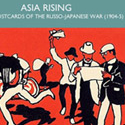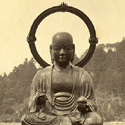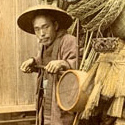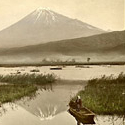|
|
| Show All 17 Results (Text Only) |
|
| Asia Rising: Japanese Postcards of the Russo-Japanese War (1904-5) |
|
|
"Imperial Japan’s 1904–05 war against Tsarist Russia changed the global balance of power. The first war to be widely illustrated in postcards, the Japanese view of the conflict is presented in images from the Leonard A. Lauder Collection of Japanese Postcards at the Museum of Fine Arts, Boston." See the ESSAY section for an in-depth, illustrated reading of the images from the historical record. See the VISUAL NARRATIVES section for a shorthand view of the unit's primary themes and images. A CURRICULUM section for teachers and students can be found under the "Asia Rising" menu at the top of the page.
Go to Museum Resource: http://ocw.mit.edu/ans7870/21f/21f.027/asia_rising/index.html | |
|
|
| Black Ships & Samurai: Commodore Perry and the Opening of Japan (1853-1854) |
|
|
"On July 8, 1853, residents of feudal Japan beheld an astonishing sight—foreign warships entering their harbor under a cloud of black smoke. Commodore Matthew Perry had arrived to force the long-secluded country to open its doors." The ESSAY section "examines graphics from the American and Japanese sides of the momentous encounter"; the VISUAL NARRATIVES section "retells topics or stories from the encounter." A CURRICULUM section for teachers and students can be found under the "Black Ships & Samurai" menu at the top of the page.
Go to Museum Resource: http://ocw.mit.edu/ans7870/21f/21f.027/black_ships_and_samurai/index.html | |
|
|
| Felice Beato's Japan: People, An Album by the Pioneer Foreign Photographer in Yokohama |
|
|
"These photos of men and women from different walks of life catered to foreign curiosity about the 'exotic' Japanese. Most were taken in [Felice] Beato's studio in Yokohama." All images with captions transcribed verbatim from the ca. 1869 album. With an in-depth essay by Alona C. Wilson.
Go to Museum Resource: http://ocw.mit.edu/ans7870/21f/21f.027/beato_people/index.html | |
|
|
| Felice Beato's Japan: Places, An Album by the Pioneer Foreign Photographer in Yokohama |
|
|
A 50-image album of images by photographer Felice Beato (ca. 1833-1908) that "features scenes along the routes that foreign sightseers travelled in the opening years of the Meiji period." All images with captions transcribed verbatim from the ca. 1869 album. With an in-depth essay by Allen Hockley, professor of art history at Dartmouth College.
Go to Museum Resource: http://ocw.mit.edu/ans7870/21f/21f.027/beato_places/index.html | |
|
|
| Globetrotter's Japan: People, Foreigners on the Tourist Circuit in Meiji Japan |
|
|
"One of the most lavishly illustrated publications of Japan at the end of the 19th century was Captain Frank Brinkley’s 10-volume Japan. This unit highlights the spectrum of native people and activities depicted in this famous publication." With an in-depth essay by Allen Hockley, professor of art history at Dartmouth College.
Go to Museum Resource: http://ocw.mit.edu/ans7870/21f/21f.027/gt_japan_people/index.html | |
|
|
| Globetrotter's Japan: Places, Foreigners on the Tourist Circuit in Meiji Japan |
|
|
"View hand-colored photographs of the sights on a typical tour of late-19th-century Japan, reproduced here from a lush 10-volume set by Captain Frank Brinkley. Comments appear from travel books by 'globetrotter' tourists of the time." With an in-depth essay by Allen Hockley, professor of art history at Dartmouth College.
Go to Museum Resource: http://ocw.mit.edu/ans7870/21f/21f.027/gt_japan_places/index.html | |
|
|
| Ground Zero 1945: A Schoolboy's Story |
|
|
"This unit presents the illustrated testimony of Akihiro Takahashi, who survived the atomic bombing of Hiroshima on August 6, 1945. Illustrations by Goro Shikoku, with English translation by Yuki Tanaka."
Go to Museum Resource: http://ocw.mit.edu/ans7870/21f/21f.027/groundzero1945_2/index.html | |
|
|
| Ground Zero 1945: Pictures by Atomic Bomb Survivors |
|
|
"These drawings and paintings by Japanese survivors of the atomic bomb were created more than a quarter century after the bombs fell on Hiroshima and Nagasaki in August 1945. They are provided by the Hiroshima Peace Memorial Museum." The ESSAY section examines Ground Zero 1945 using the images by survivors of the atomic bomb blast; the VISUAL NARRATIVES section features the story of one survivor who tells her story through images.
Go to Museum Resource: http://ocw.mit.edu/ans7870/21f/21f.027/groundzero1945/index.html | |
|
|
|
| Show All 17 Results (Text Only) |








